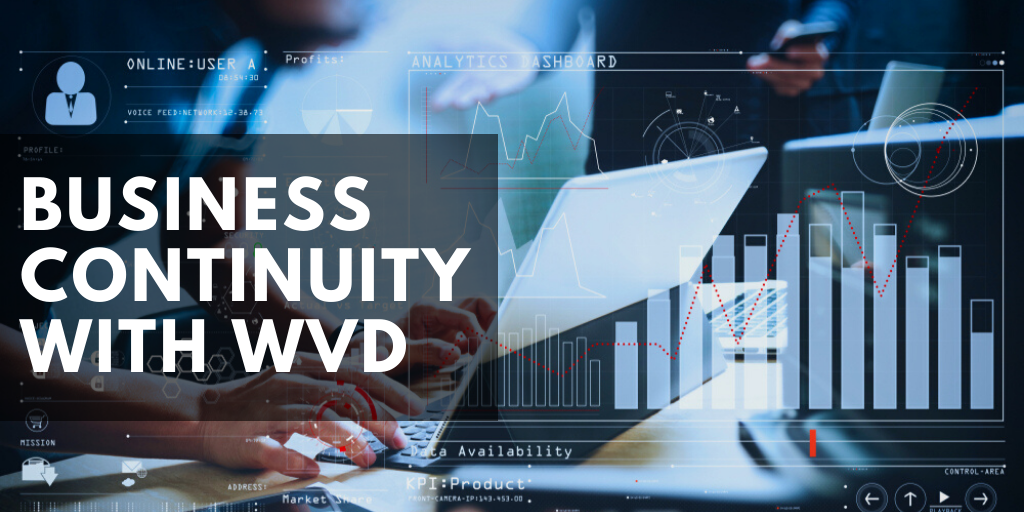
Disruptions to business continuity are costly. Moreover, defending against them can feel overwhelming, as the possible causes range from sudden hardware failure to cyberattacks such as ransomware infections. So what’s the best option for hedging against the full range of possibilities and ultimately maintaining resiliency as well as a competitive advantage?
What is Business Continuity?
At its heart, effective business continuity requires both a clear plan and the right solutions to put it into action.
A business continuity plan is a document describing how an organization will continue to operate in the wake of an unplanned disruption. This asset may include details on backups and data centers, plus the use of virtualization and cloud environments, e.g., a virtual desktop infrastructure (VDI) solution for delivering desktops to remote employees from Microsoft Azure.
On the IT side, solutions that support business continuity include VDI, disaster recovery services (managed either on-premises or in the cloud) and collaboration tools. Redundant utilities and other basic infrastructure are also key components of business continuity strategies.
Despite the significant risks of being caught flat-footed in a disaster, many organizations don’t have the right combination of business continuity planning and technical tools in place:
- A late 2018 Spiceworks community survey found that although 95% of respondents had created business continuity plans at that time, many of their plans weren’t comprehensive.
- For example, only 57% had covered local application and server uptime in their DR planning, along with only 50% for network security and 62% for network connectivity.
- A quarter of all the survey participants had never tested their plans, which further increases risk. There’s no way to know if even the most theoretically robust business continuity solution will work if it isn’t trialed beforehand.
The COVID-19 pandemic underscored the importance of having a sound and thoroughly tested business continuity plan, with many organizations needing to rapidly shift to remote work to sustain their critical business operations. Gartner estimated that only 12% of organizations were well-prepared for this transition.
However, on the bright side, the rise of cloud-based disaster recovery solutions (i.e., DRaaS) and VDI offerings such as Windows Virtual Desktop (WVD) have made it more practical to preserve business continuity than in years past. Let’s take a closer look at WVD, in particular, to see how it delivers an operational and competitive advantage in maintaining business continuity.
What is WVD and How Does it Work?
WVD is a Platform-as-a-Service (PaaS) solution for delivering Windows desktops and apps via Azure. It is a form of VDI, and one that has some unique benefits in terms of its cost structure, security features and overall user experience.
Stepping back for a moment, VDI, in general, is useful for business continuity purposes because it enables end-users to access the desktops and applications they need for their work – even if they are not in front of the original physical client device running that software, for instance a traditional in-office PC. They can instead authenticate into the VDI solution from afar and be securely connected to a virtualized desktop or app.
But not all VDI implementations are created equal. Security, performance and support for specific services and workflows vary between solutions, which is why it’s a good idea to select a platform that works with business-critical applications and is generally easy, safe and economical to use. WVD excels on all of these metrics.
Support for Business Critical Applications
WVD is the only VDI solution that can deliver a multi-session Windows 10 experience (meaning as many users as you want per virtual machine), with a native user experience. It also includes optimizations for Office 365 ProPlus, with real-time Outlook search and top-notch calendar and email performance. Microsoft App Assure also checks app compatibility. Everything is kept up to date and secure and can be scaled on-demand to a wide range of support devices. That way, end users can consistently access what they need even if a disaster like a storm health or public health emergency prevents them from going into the office.
Ease of Use
The streamlined administration of WVD allows for quick deployment of apps in the cloud from an intuitive interface. Azure also offers a single portal for managing both desktop and RemoteApp groups, and it’s possible to migrate an existing Remote Desktop Services (RDS) environment to Azure for simplified management in the cloud. The same Azure credentials used elsewhere can be used for managing WVD resources and leveraging capabilities such as automated virtual machine (VM) deployment.
Platform Security
Remote access to apps and desktops must be secure, or else the entire purpose of the business continuity plan is negated: A data breach is just the type of disruption that negates continuity planning in the first place. WVD includes sophisticated Azure security services configurable through Azure Active Directory, which serves as its identity provider. The reverse connect technology within WVD means that inbound ports on destination VMs don’t need to be opened, a setup that greatly reduces the attack surface of the solution. Plus, single- and multi-session users are always securely isolated.
Cost Savings
Like other PaaS offerings, WVD delivers savings on infrastructure and labor since its key resources are hosted in Azure and professionally managed. But there are some further economic benefits, too. Adopting WVD comes with three years of free extended security updates for Windows 7 and can yield savings on the RDS Client Access License (aka CAL) model.
How Can You Get Started With WVD?
Business continuity planning is an essential but often neglected task. To help ensure you’re prepared, the Hanu team is here to help you chart a path into WVD and to take advantage of multiple Azure services for better protection against a full spectrum of possible disruptions.
We have guided customers through managed transformations, application modernization, data center consolidation and more, ensuring that each project received properly configured and supported services within Azure. In addition to WVD, we offer help with DRaaS and managed services to keep your business-critical environments up and running even in the face of disruptions. Learn more by signing up for one of our complimentary business continuity workshops.



